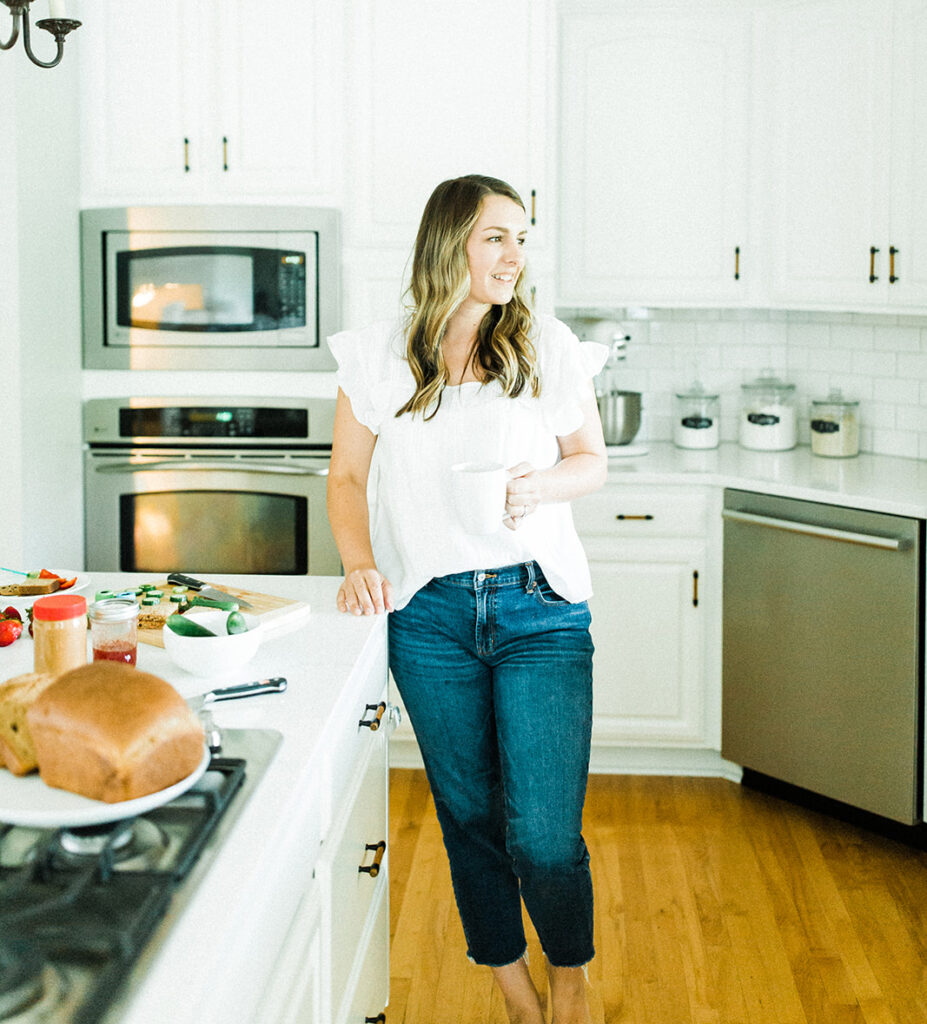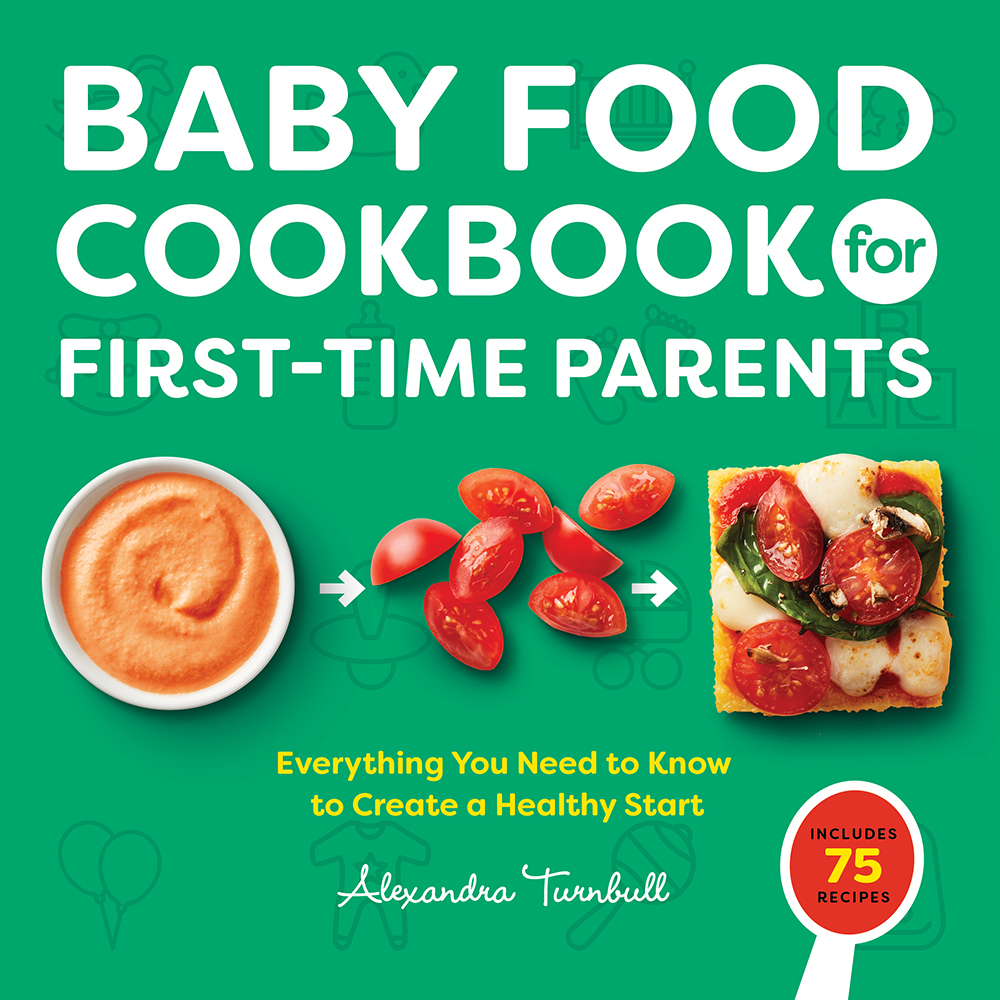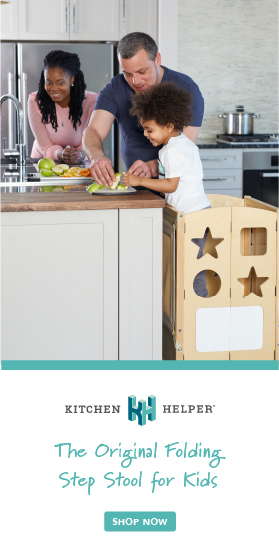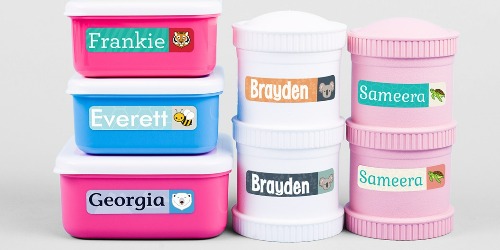This post may contain affiliate links.
Convenience, especially regarding food, can help you make healthier choices; frozen steamer veggies, individually packed hard-boiled eggs, and applesauce pouches. But convenience always comes with a price. In this case, it’s more trash, mainly plastic.
I’m not going to lie, I rely heavily on conveniently packaged foods to make feeding my family easier. Maybe you do too?
If you find yourself relying heavily on convenient products that just fill your trash can, I’m here to share 10 ways to reduce waste at home because every little bit helps.
Table of Contents
1. Reusable Water Bottles
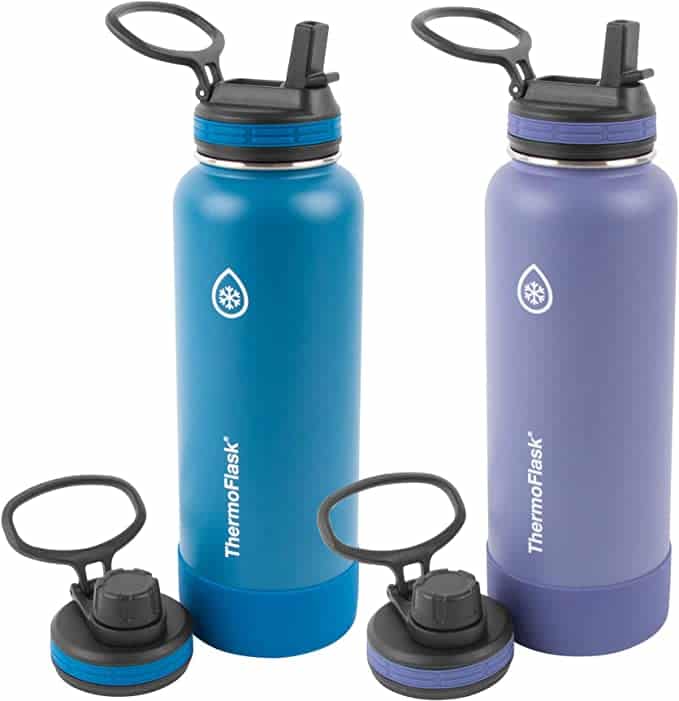
I’ve been using a reusable water bottle for 15 years now. It’s the easiest swap you can make to help reduce waste, especially plastic.
I’ve gone through quite a few reusable water bottles trying to find the perfect one. Two years ago I found a set of Thermoflask 40 oz Insulated Stainless Steel water bottles at Costco. I love this water bottle for several reasons:
- It’s large enough that I don’t have to keep refilling it constantly.
- It has a straw which makes spills few and far between.
- It has a handle which is essential when carrying 10 different things at a time.
Instead of using plastic, single-use water bottles, opt for the simple swap of a reusable water bottle of your choosing.
2. Swedish Dishcloths
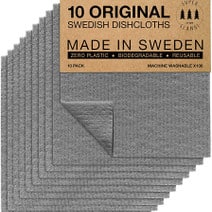
If you have kids, you likely clean up a lot of spills and can go through a roll of paper towels quickly.
Instead of going through so many paper towels, opt for a reusable product like Swedish Dishcloths. They’re extremely absorbable and can be tossed in the washer once done. I use mine for one to two days or until it gets too dirty to use.
I recommend laying out flat versus drying but always follow the manufacturer’s directions for washing.
3. Reusable Food Pouches
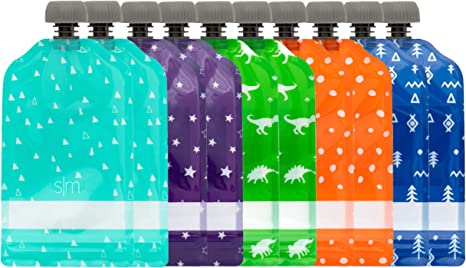
Not going to lie here, we go through quite a bit of single-use fruit and veggie pouches. They’re just so convenient, especially as an on-the-go snack.
And let me tell you, it’s absolutely fine to utilize these convenient food pouches to help make eating fruits and veggies on the go easier, and did I mention shelf stable?
If you can, try to utilize food pouches more for on-the-go and aim for other forms of fruits and veggies at home when you have more time.
While it does take more time, and they’re not necessarily shelf stable, packing your own reusable fruit and veggie pouches can help minimize waste.
I do like to use the Simple Modern reusable pouches for yogurt. This way I can buy the bulk yogurt our family prefers and make them myself instead of being limited to the minimal options of single-use yogurt pouches that are available at our grocery store.
Check out how easy they are to use here.
4. Silicone Covers
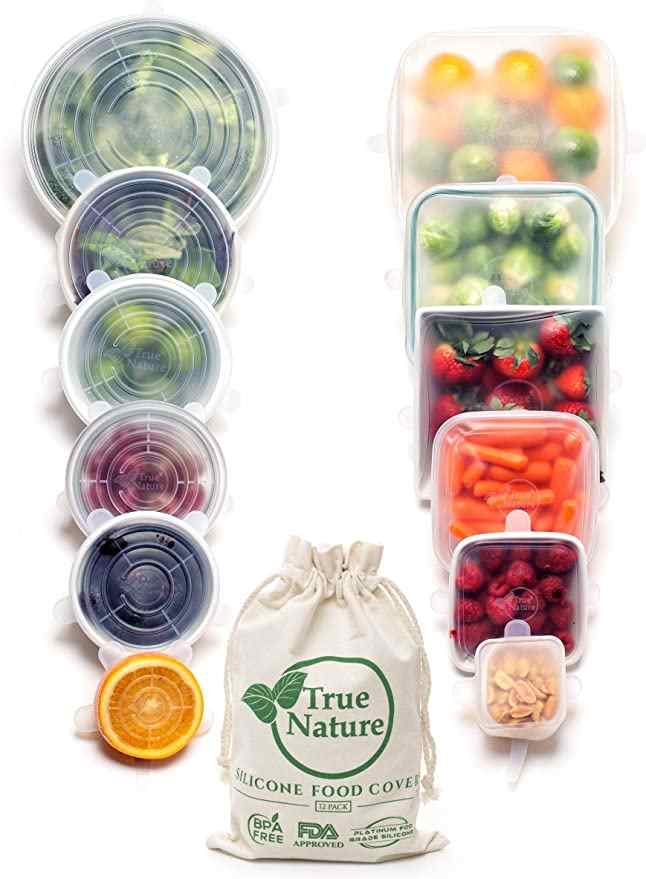
I bought my first set of silicone food covers in 2021 and I’m obsessed. We serve a lot of meals family-style out of bowls and I hate to add to the pile of dishes by transferring the food to another container. Instead, I just slip on a silicone cover and pop it in my fridge.
The only downside to these silicone covers is that if your bowl or dish is a little wet, they do slip off.
5. Beeswax Wraps
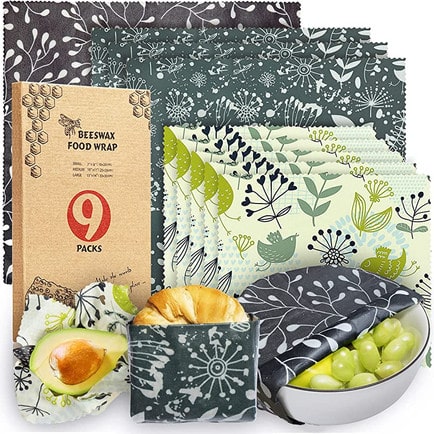
Here’s another solution to covering leftovers; beeswax wraps. Yes, they use beeswax to help make it easy to mold and stick, while also being food safe.
I use beeswax wraps to cover leftovers, wrap up cut fruit or vegetables, and even as a ‘bag’ for certain foods I’m taking on the go like sandwiches.
Avoid washing with warm or hot water, as it will melt the beeswax. Cold, soapy water and air dry will do the trick.
6. Reusable Bags
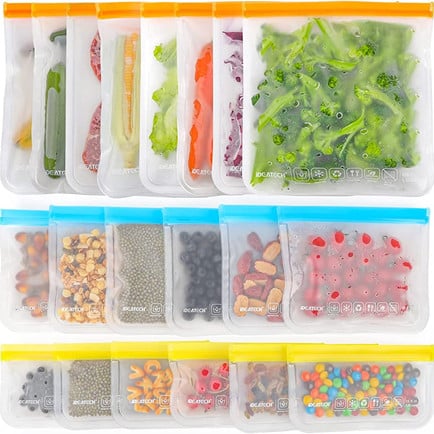
I haven’t gotten rid of my Ziploc bags completely because they’re great for certain wet and sticky foods that I don’t want to have to wash out of my reusable bags.
We use reusable bags for less messy foods like homemade pancakes, dry snacks, and fresh vegetables.
The downside is that handwashing reusable bags isn’t the most fun. You have to somehow keep them open so they don’t stay wet inside. I usually place them over a glass and they dry up pretty quickly.
I pack most of my daughter’s snacks in our reusable bags.
7. Reusable Grocery Bags

Many cities, states, and countries have gone away with plastic bags and instead offer paper or reusable ones for a price or encourage you to bring your own.
Here in Minnesota, that change has not gone into effect, but I’ve made it a habit to use my own reusable grocery bags, at least when I remember them.
I absolutely love these reusable grocery bags. They’re easy to carry and hold so much more than your standard plastic bag. You just have to remember to bring them in!
8. Use Bulk Foods

I’m guilty of purchasing individually packed foods purely for convenience. I know it doesn’t take that long to pack a few crackers from a large container into a reusable bag, but when I’m trying to head out the door with two kids and I need to grab a few quick snacks, I lean on convenience.
However, I do try to buy bulk when I can to even things out at least a little. We love buying the larger, bulk containers of yogurt, goldfish, and other crunch snacks we go through a lot of.
Some things just don’t come in bulk, so buy bulk where and when you can with what you have access to and know you can go through because purchasing bulk can also add to food waste if it goes uneaten prior to its expiration.
9. Refillable Cleaning Products
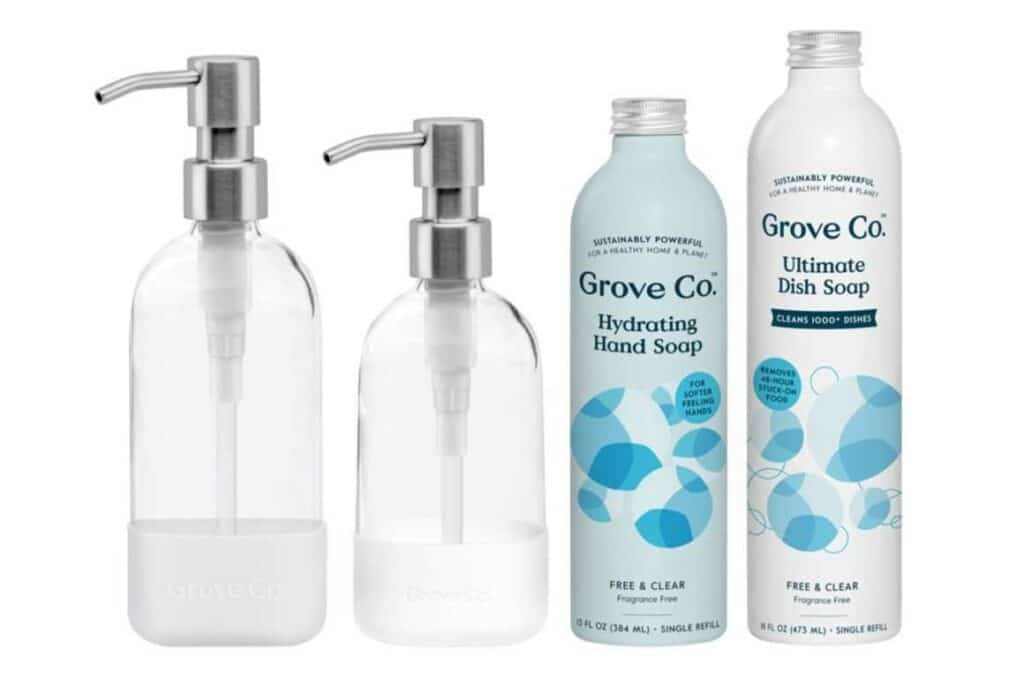
There was a point in time when I said I was going to switch over all my cleaning products to a more eco-friendly version that didn’t involve so much plastic. I soon realized that switching over everything was overwhelming, expensive, and would create quite a bit of waste.
Instead, I slowly switched over my single-use bottles of cleaning products to refillable containers as they ran out.
My hand soap, dish soap, and multipurpose cleaners are now all in glass containers that I can refill once they are out.
You can even go to the extent of getting concentrated liquids and tablets that help minimize the packaging of the refillable products too.
We use Grove to purchase our eco-friendly cleaning products and containers.
10. Compost Bin

I always felt bad when I’d have to toss food into the trash, even the unsalvagable food so I started composting to help, at least a little.
First, we started with a countertop compost bin and we used compostable bags to add to our trash can because our waste management company would sort these out.
Then we acquired an outdoor compost bin in hopes to use the compost in our raised garden bed.
If you’re not sure how to start composting, read more here.
To learn how to minimize food waste, read more here.
Start to Reduce Waste at Home Now

Please don’t try to attempt all of these waste-reducing strategies all at once, it will be far too overwhelming. Pick one and go from there. Your options include:
- Using a reusable water bottle instead of single-use plastic water bottles
- Adding in a Swedish Dish Cloth in addition to your paper towels
- Trying out reusable food pouches to minimize single-use pouches
- Using silicone food covers for leftovers
- Using bees wax wraps to cover foods
- Adding reusable bags to your Ziploc collection
- Opting for a reusable grocery bag instead of plastic bags
- Using bulk foods when it comes to your favorites
- Switching to refillable products as you run out of your single-use plastic products
- Starting to compost your food waste instead of tossing in the trash
You might not feel like you’re making a big difference, but over time you are and you may even inspire someone else to make a change too.

